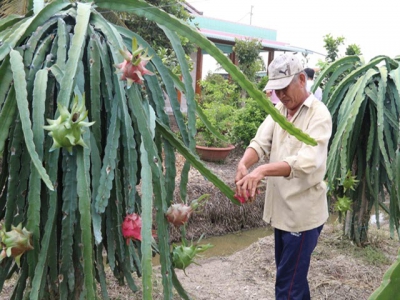Tiền Giang continues to expand fruit growing area

TIỀN GIANG — More farmers in flood-prone areas in Mekong Delta Tiền Giang Province’s Cái Bè District have turned their low-yield rice fields into specialty fruit orchards and are earning high incomes.
Harvest of dragon fruit in Tiền Giang Province’s Chợ Gạo District. — VNA/VNS Photo Minh Trí
In the last three years, they have converted 2,945ha of paddies and now grow Thai jackfruit on more than 1,700ha of those lands and durian on 600ha, according to the district People’s Committee.
The district expects to add 1,300ha this year and 1,170ha next year, mostly near closed dykes and residential areas.
In some areas, the jackfruit trees have begun to borne fruit and offer farmers incomes of VNĐ1 billion (US$43,080) per hectare a year, according to the People’s Committee.
But the conversion is mostly unplanned and many rice farmers have switched to fruits in areas zoned for rice, according to local authorities.
Fruit orchards in areas that lack closed dykes for preventing floods and high tides face the risk of severe damage.
Phạm Văn Thanh, head of the Cái Bè Agriculture and Rural Development Bureau, said the district has petitioned authorities to allow the conversion of rice fields to the south of the Trung Lương-Mỹ Thuận expressway and north of National Highway No.1 into orchards.
Cái Bè has 16,350ha of fruit orchards.
The district’s fruit farmers earn an average of VNĐ98.2 million ($4,230) per hectare per year since their specialty fruits such as Hòa Lộc mango and Lông Cổ Cò grapefruit are popular with consumers.
The district has set up 100ha of concentrated areas to grow Hòa Lộc mango to Vietnamese good agricultural practices (VietGAP) standards.
Its Hòa Lộc Mango Co-operative purchases the entire output of the 100ha and sells to Hà Nội and HCM City and exports to Japan.
Tiền Giang, the country’s largest fruit producer, has more than 77,700ha under fruits, according to its Department of Agriculture and Rural Development.
In recent years, the province has encouraged farmers to establish co-operatives and link up with companies to guarantee outlets for their fruits.
A tie-up between farmers and Hương Miền Tây, a fruit exporting firm in Bến Tre Province, for green peel and pink flesh grapefruits in Mỹ Tho City has been successful model since beginning in 2016.
Hương Miền Tây buys an average of 400 tonnes of grapefruit at a reasonable price.
Many fruit export co-operatives and companies have established quality fruit growing areas.
Cao Văn Hóa, deputy director of the province’s Department of Agriculture and Rural Development, said co-operative teams, co-operatives and companies have established concentrated fruit growing areas and this helps develop the province’s fruit orchard economy.
The province will expand a programme to provide advanced techniques for intensive fruit farming, producing fruits in the off-season and mechanising fruit cultivation.
Có thể bạn quan tâm
 Hung Yen oranges win customers’ trust
Hung Yen oranges win customers’ trust Hung Yen has about 24,000 ha of fruit trees, 15,000 ha of which are oranges and mandarins.
 High-tech farming significant to improve sugarcane quality, productivity
High-tech farming significant to improve sugarcane quality, productivity Applying advanced technologies in the cultivation of sugarcane is important to improve quality and productivity of the giant tropical grass
 To improve agricultural quality
To improve agricultural quality In recent years, thanks to the effective application of modern science and technology into agricultural production, the value and competitiveness of agricultura